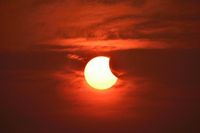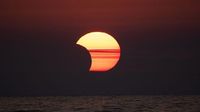On Saturday, March 29, 2025, a partial solar eclipse will grace the skies across various regions, including parts of the United States, Canada, the Caribbean, Europe, Russia, and Africa. This celestial event, while not as dramatic as last year's total solar eclipse, presents a unique opportunity for people to step outside and marvel at the wonders of our solar system.
The eclipse will begin early in the morning, with the moon starting to pass across the sun shortly after 10 a.m. GMT. In the UK, the phenomenon will peak around 11 a.m. when roughly a third of the sun's light will be blocked by the moon. The entire event will last about two hours, concluding around midday.
In North America, the eclipse will be visible at different times and intensities depending on the location. For instance, in Boston, 43 percent of the solar surface will be covered at 6:38 a.m. Eastern. Meanwhile, New York City will experience a 22 percent eclipse at 6:46 a.m., and Washington, D.C., will see only a 1 percent coverage at 6:59 a.m. The most significant obscuration will occur in northern Quebec, Nunavut, and much of Newfoundland and Labrador in Canada, where over 90 percent of the sun will be hidden by the moon.
Across the Atlantic, northern and western Europe, along with the northwestern coast of Africa, will witness the eclipse at various times during the late morning or early afternoon. In places like Halifax, Nova Scotia, the moon will glide over 83 percent of the sun, creating a spectacle that lasts more than an hour. Conversely, in Buffalo, New York, where the eclipse will only reach a maximum of 2 percent, the event will last just seven minutes.
But what exactly is a partial solar eclipse? It occurs when the moon slides between Earth and the sun, partially obscuring the solar surface from our view. Unlike a total solar eclipse, which plunges observers into darkness, a partial eclipse only covers a portion of the sun, meaning the sky won’t darken enough for stars or planets to become visible during the day.
Stargazers should remember that looking directly at the sun, even for a few seconds, can cause permanent damage to the eyes. Therefore, protective eyewear is necessary for safe viewing. If you saved your eclipse glasses from last year's total solar eclipse, you can use them again, provided they are not damaged. Alternatively, you can create a pinhole projector using simple materials like cardboard or a kitchen strainer to safely observe the eclipse.
For those in the UK, the best views of the eclipse will be in the northwest of Scotland, where 47.8 percent of the sun will be obscured. In contrast, the southeast of England will see only 28.1 percent of the sun covered. The Met Office predicts the best visibility will be in southern and southeast England, the Midlands, and the northeast, while areas like northwest England and Wales may experience significant cloud cover.
As this partial solar eclipse unfolds, it offers a reminder of the astronomical wonders that occur above us. In fact, another partial solar eclipse is set to happen on September 21, 2025, best viewed in Australia. Additionally, a total solar eclipse will occur in the summer of 2026, visible in the upper parts of the Northern Hemisphere. For those who enjoy lunar events, two total lunar eclipses are also on the horizon, one in September 2025 and another in March 2026.
The excitement surrounding this partial solar eclipse is palpable, especially for those who missed last year's total solar eclipse. This upcoming event serves as an invitation for everyone to step outside, look up, and appreciate the cosmic dance of celestial bodies. Whether you're in Boston, New York, or Scotland, mark your calendars and prepare for a moment of awe as the moon casts its shadow across the sun.
As we gear up for this astronomical occurrence, it's essential to understand the significance of safely observing the eclipse. The Royal Museums Greenwich recommend using ISO-approved solar eclipse glasses or creating a pinhole projector for those looking to witness the event without risking their eyesight. This simple preparation can ensure that viewers enjoy the spectacle safely.
So, gather your friends and family, grab your eclipse glasses or make a pinhole projector, and get ready to enjoy a remarkable celestial event. The partial solar eclipse on March 29, 2025, promises to be a beautiful reminder of the wonders of our universe, and it’s an occasion not to be missed!



